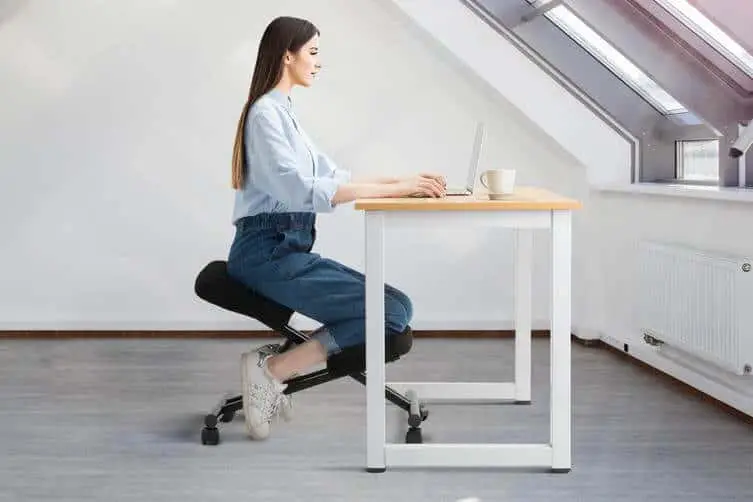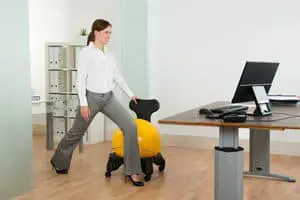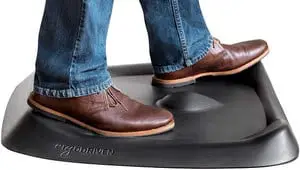Whether you’re struggling with back pain or you’re simply looking for a more comfortable way to work at a desk for long periods, the thought may have come across your mind—is kneeling better than sitting?
Kneeling is generally better than sitting because kneeling or squatting involves more muscle activity compared to sitting. By having more consistent muscle activity throughout the day, kneeling and squatting can reduce the health risks associated with sedentary behavior.
So, in short, yes, squatting/kneeling is much better for you than sitting. We’ll show you why in this article, including scientific evidence to back it up.
Are you ready to discover a new and more healthy way to spend time at your desk? Set your laptop on a low-lying surface, grab some padding for your knees, and let’s begin.
At Office Solution Pro, we are passionate about Ergonomics! Our readers support the page. If you click on a link, we may earn a small commission at no cost to you. We hope you love the products we recommend as much as we do!
Is Kneeling Better Than Sitting?
Let’s explore this topic by starting with the benefits of kneeling and continuing with the science behind kneeling. Once we have that covered, we will show you how to maximize kneeling to create the ultimate healthy workstation.
Why Kneeling is Good for You
Like standing and sitting, kneeling is a natural human position. However, unlike sitting, kneeling requires more strength from your body to maintain the position, especially your core. In fact, the narrower your kneeling stance is, the more your abdomen will have to work to keep you balanced.
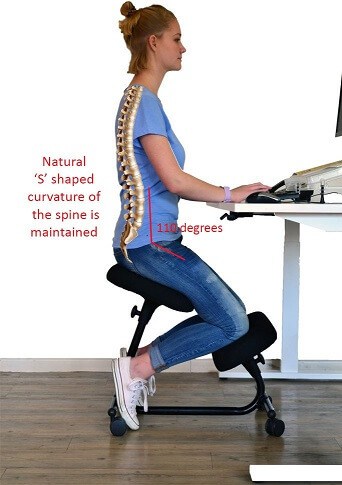
Before we continue, it’s important that we establish this: There are two kinds of kneeling you can do.
The first is a half-kneel, where you keep one leg bent at a 90-degree angle and the other leg on the ground. That position allows you to switch legs to stay comfortable in the position for a longer amount of time.
Alternatively, you can go into a full kneel, which engages more muscles and, therefore, offers even more health benefits. Below are some of the biggest benefits of kneeling over sitting:
- Builds muscle strength
- Improves posture
- Burns more calories
- It’s a more neutral position for the spine
Although kneeling is good for your body, like any activity that requires muscle, you’ll need to take breaks. Therefore, another benefit of kneeling is when you’re not kneeling—it forces you to get up and move around before returning to the position.
Kneeling also benefits people who struggle with back issues. Evolution didn’t design the human body to sit as much as people do in the modern world. As a result, some people suffer from disc bulges and herniations.
Additionally, sitting for long periods negatively affects the hips because it keeps them in a narrower position. The impact of this is surprising to people who aren’t well versed in biology—curling your body into a smaller space reduces the room your lungs and digestive system have to perform their tasks.
Because keeling helps you keep your body open, it improves breathing, allowing more oxygen to reach your brain and increasing your focus.
The Science Behind Keeling
To understand why kneeling is good for you, it’s equally important to understand what makes sitting so bad. According to the Mayo Clinic, health conditions that sitting can trigger include:
- Obesity
- High blood sugar
- High blood pressure
- Poor cholesterol levels
Harvard Health also chimed in on their concern over people spending an increasing amount of time sitting. Although research hasn’t proved why too much sitting causes harmful consequences, they believe it could be because the gluteus maximus is the largest muscle in the body.
Since relaxed muscles take less glucose from the blood, that could result in an increased risk of diabetes and other diseases.
Equipped with the knowledge that prolonged sitting isn’t good for the body, researchers decided to study the impact of kneeling on health. According to a study conducted at the University of Southern California, the Tanzanian people they worked with, who live much like our ancestors, are mostly sedentary.
However, the Tanzanians spent their nine to ten hours of rest per day in mostly kneeling or squatting positions. As a result, their muscles are in a constant state of activity.

Hunter-gatherer tribes are used to kneeling and squatting. They activate their muscles even when resting.
The study noted that it’s human nature to want to conserve energy. So, by choosing to kneel instead of sit, they believe that people will reduce the risk of suffering from ailments that so commonly plague the modern-day office worker without having to exert too much energy.
What About My Knees?
If you’ve kneeled for any length of time, you likely know that it can bother the knees, especially if you’re kneeling on a hard surface. The same can also be said if you are not used to kneeling.
For that reason, we recommend kneeling on a pad or any other soft material. You can also consider purchasing an ergonomic kneeling chair. These chairs have two angled pads—one for your bottom and the other to set your shins on to keep your knees well-cushioned.
Unlike regular chairs, keeling chairs don’t have a back. Therefore, your core remains tight to keep you upright, and the chair’s angle helps align your spine naturally.
If you’re interested in incorporating kneeling into your workday, consider investing in the best ergonomic kneeling chairs to reduce your sedentary lifestyle and become healthier.
How to Kneel to Maximize Health Benefits
It’s best to take a gradual approach when kneeling, for your body will need to build up muscles. Even then, you’ll likely only be able to kneel for 15-minute increments before getting up to shake out your legs. Remember, being out of a kneeling position to move around is part of why kneeling is so beneficial.
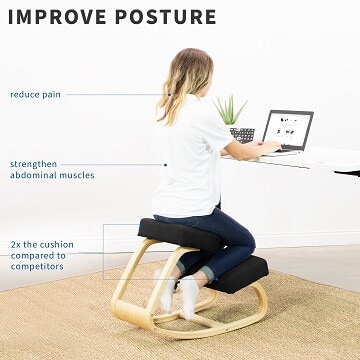
To get started with kneeling, you’ll need to rearrange your working space. Choose a low-lying table where you can work from your laptop at eye level—a coffee table is a good option. It’s also important to keep your keyboard and mouse close so that you don’t have to force yourself into a poor posture to reach them.
Once you get down into a kneeling position, check your body for the following:
- Your back should be flat except for a small arch in your lower back.
- Open your hips so that you can lean slightly forward while ensuring your back remains flat.
- Keep your arms parallel with the ground or open them at a more than 90-degree angle.
- Your neck is an extension of your spine, so you need to keep it straight with your back.
Finally, while typing, keeping your wrists neutral will prevent pain and promote a healthy posture.
Ready to Switch to Kneeling?
Studies are in! Kneeling is better for you than sitting. You may get some funny looks from coworkers if you work in an office, but don’t be surprised if they start joining you. Kneeling is a free and easy way to improve your health, so why not try it out today?
